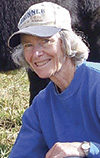In the past two decades, some stockmen have pushed this concept farther with short-duration grazing, moving cattle more often and breaking pastures into smaller segments.
Management intensive grazing (MIG) involves moving cattle frequently (sometimes as often as once or twice a day), grazing the top of the plants and moving on to a new pasture.
This is a way to increase cattle performance as well as pasture productivity.
How long the animals stay in one place before being moved to the next paddock, pasture or strip will depend upon the size, type of pastures and forage species, whether it’s rangeland or irrigated pastures, etc. and upon the purposes and goals of the stockman.
Nutritional needs of the animals are also a factor, whether they have high requirements (such as lactating cows or young, growing stocker cattle) or lower needs (such as mature dry cows).
Maximizing pasture production and allowing cattle to graze as much of the year as possible helps improve any rancher’s bottom line. As pointed out by Jim Gerrish, American Grazinglands Services of May, Idaho, finding ways to allow cattle to harvest forage is the most cost-effective management tactic. “Stored feed costs are the biggest expense for most cow-calf producers,” he says. If pasture production can be increased, grazing can often be extended longer, into the fall and winter.
During the growing season, efficient pasture rotation can keep plants at a higher level of production, which is beneficial for animal performance.
The MIG system utilizes grass while it is still in vegetative (growing) stage while nutrient levels are high. “Multiple moves per day, if done correctly, with attention to the degree of utilization and focusing on animal performance, is a good tool for increasing individual animal performance,” explains Gerrish.
“You can get a good boost in milk production with a dairy, or rate of gain in stocker or finishing animals, but the key is doing it right. This means multiple moves without utilizing an excessive amount of the forage. You are basically still taking half and leaving half,” he says.
Paddock design
Ranchers who haven’t tried it worry about the time it takes to move cattle this often. “We are running 500 pairs and moving them once a day.
For me to walk to the pasture, move the fence and get back to the house takes about 45 minutes. If I ride the ATV it takes about 25 minutes,” Gerrish says.
It’s not very time-consuming if you plan it right. “Each time I move cattle, I am moving about 1,000 feet of poly wire.” He uses two fences, putting the next one up before he takes the one in front of the cows down.
“If you have pastures several miles away and try to do this, it could take more time and fuel. I advise people to first try it on pastures closest to home – since those will be the most convenient to do,” he says.
“We built very little permanent fence. We lay everything out in strips. On a center pivot, these are round strips. On square fields we lay out parallel strips.”

Gerrish likes working with strips 600 to 800 feet wide.
“It doesn’t matter how long they are. A strip 660 feet wide and a mile long is 80 acres. If you have done your homework and figure your herd needs 20 acres per day, it would take four days to get across one of those strips, and you might feed the grass in four-acre or five-acre pieces by making several moves per day. This gives you flexibility to increase or decrease the number of moves per day,” he says.
If you had a square section laid out in eight 80-acre strips, you’d be moving the same length of fence every day. “It would probably take about 12 minutes to make the 660-foot shift,” he says. This makes the system very efficient.
Avoid laying out paddocks where you’d have to move more than a quarter-mile of poly wire each time.
“A standard fence reel holds a quarter-mile and the number of step-in posts that you’d need for that length of fence is easy to carry. If you go longer distances you need a bigger reel and have more posts to carry. It becomes awkward to get the job done in a short time,” explains Gerrish.
When laying out parallel corridors, most people locate watering points on every other fence, so each waterer serves two corridors.
Weed control
High-intensity grazing aids weed control. “Some weeds are still there, but our cattle top out Canada thistles and musk thistles – eating buds and flowers.
When they are on flood-irrigated pastures where there’s any knapweed, they completely clean up the knapweed,” says Gerrish. There isn’t much left to go to seed.
Whether it grows back soon enough to go to seed depends on how long your recovery period is.
“Knapweed can be chewed down to just a short stem and will grow back and make seeds if your recovery period is very long. On our pivots, most of the time our recovery period is not long enough for it to come back and make seed before it gets grazed again. But on our flood-irrigated ground that we typically only graze twice during the season (rather than three times), we might get knapweed well utilized in the first grazing but, before we get back to it, these plants may go to seed,” he explains.
Animal concerns
Some people wonder about confining cattle in small grazing areas, rotating through pastures without windbreaks or shade.
“This can make a difference in cattle performance, depending on where you are located. Here in the Pahsimeroi Valley in eastern Idaho, I don’t worry about shade because our climate is dry not humid. Even on days it gets up to 95 degrees, it’s a dry heat and these animals exhibit no signs of stress,” says Gerrish.
Some body heat is dissipated via sweat into the dry air. High-elevation regions cool off at night and cattle can dissipate accumulated body heat.
“By contrast, in Missouri, cattle would be suffering at high temperatures and we’d be more concerned about whether they had shade. But if you have genetically adapted cattle that are heat-tolerant, which was what we had when we lived in Missouri, it’s less of an issue … Shade and windbreak considerations depend on your climate and breed of cattle.” ![]()

MIG grazing at Eagle Valley Ranch
Mike Kossler, who works for Eagle Valley Ranch near Salmon, Idaho, says their MIG system has enabled them to increase pasture productivity and allow cattle to graze longer into winter – greatly reducing winter feed costs. The ranch is 6,000 acres and runs about 600 to 700 cows.
“Our BLM range permit is small. Traditionally it was used for spring turnout, bringing cows home in summer and going back out in August/September.
We changed it to fall grazing for dry cows. We keep the weaned calves on irrigated pastures and turn cows out from September 15 until December 15,” he says.
“We calve late, starting March 20, to stay away from cold weather, since everything calves outside,” says Kossler.
Even though calves are only 7 months old at sale time, by doing intensive grazing the ranch is able to sell 600-pound calves.
“We move the cattle every 24 hours. We assess grass in pasture cells and want it six to 10 inches high when we go in and at least three to four inches when we leave.
At that height, there are some bottom leaves left on the plant and it recovers faster,” he says.
Depending on time of year, they may not come back to that same piece of ground for 30 to 90 days. “In mid-July, for instance, grass doesn’t grow as fast in the heat and needs more time to recover,” says Kossler.
“And at some point, we leave residual grass for winter. Many ranches in our area use continuous grazing (no rotations) and everything is eaten off before winter,” he says.
“All of our irrigated pastures are cell grazed. When we first go out in the spring we might have 300 to 400 cows on 200 acres. We let them top it off and move on.
By the time the grass really comes, we graze in smaller areas more intensively. The cows might then be on 1.5 to three acres.”
With the MIG system, they can usually let cows keep grazing into February or early March with no hay – just a protein supplement (corn gluten). “I used to think that if we could get into January or early February we’d be doing well, but most years we’ve been able to graze longer than that,” says Kossler.
“When you cut winter hay consumption from 2.5 tons per cow down to 1.5 tons, that makes a huge difference, especially the way hay prices have been.” ![]()
PHOTOS
TOP: High-intensity grazing is an effective control for weeds, especially on flood-irrigated fields.
MIDDLE: Working a strip 600 to 800 feet wide provides greater flexibility to increase or decrease the number of moves per day.
BOTTOM: Eagle Valley Ranch employees moving cows into their next grazing paddock. Photos courtsey of Heather Smith Thomas.









